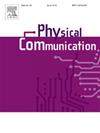Optical true time delay based hybrid beamforming for RIS-aided mmWave multi-user MISO systems
IF 2
4区 计算机科学
Q3 ENGINEERING, ELECTRICAL & ELECTRONIC
引用次数: 0
Abstract
Reconfigurable intelligent surfaces (RISs) have emerged as a promising wireless technology for the 6th generation (6G) wireless systems. Herein, we investigate the joint passive- and hybrid- beamforming (JPHBF) optimization problem in RIS-aided millimeter-wave (mmWave) multi-user MISO (MU-MISO) systems. Furthermore, we introduced codebooks into analog- and passive- beamforming design for low training and feedback overheads. We proposed optical true time delay (OTTD)-based sub-connected hybrid beamforming (SC-HBF) with a low hardware cost and low channel estimation overheads. Compared to the traditional SC-HBF implementation, only about half of the optical true time delay pool based phase control units (OTTDP-PCUs) are required. We design the codebook-based passive- and analog- beamforming (PABF) under the constraints improved by the use of about half of the OTTDP-PCUs and the passive nature of RISs. The results show that the use of multiple RISs significantly improves the sum rate, specifically an improvement of approximately 284.5% at 25 dBm total transmit power. Although only about half of the OTTDP-PCUs are used, the proposed OTTD-based SC-HBF achieves near-optimal sum rates. Moreover, we presented a design example of the optical wavelength matrix used to map the OTTDP-PCUs.
求助全文
约1分钟内获得全文
求助全文
来源期刊

Physical Communication
ENGINEERING, ELECTRICAL & ELECTRONICTELECO-TELECOMMUNICATIONS
CiteScore
5.00
自引率
9.10%
发文量
212
审稿时长
55 days
期刊介绍:
PHYCOM: Physical Communication is an international and archival journal providing complete coverage of all topics of interest to those involved in all aspects of physical layer communications. Theoretical research contributions presenting new techniques, concepts or analyses, applied contributions reporting on experiences and experiments, and tutorials are published.
Topics of interest include but are not limited to:
Physical layer issues of Wireless Local Area Networks, WiMAX, Wireless Mesh Networks, Sensor and Ad Hoc Networks, PCS Systems; Radio access protocols and algorithms for the physical layer; Spread Spectrum Communications; Channel Modeling; Detection and Estimation; Modulation and Coding; Multiplexing and Carrier Techniques; Broadband Wireless Communications; Wireless Personal Communications; Multi-user Detection; Signal Separation and Interference rejection: Multimedia Communications over Wireless; DSP Applications to Wireless Systems; Experimental and Prototype Results; Multiple Access Techniques; Space-time Processing; Synchronization Techniques; Error Control Techniques; Cryptography; Software Radios; Tracking; Resource Allocation and Inference Management; Multi-rate and Multi-carrier Communications; Cross layer Design and Optimization; Propagation and Channel Characterization; OFDM Systems; MIMO Systems; Ultra-Wideband Communications; Cognitive Radio System Architectures; Platforms and Hardware Implementations for the Support of Cognitive, Radio Systems; Cognitive Radio Resource Management and Dynamic Spectrum Sharing.
 求助内容:
求助内容: 应助结果提醒方式:
应助结果提醒方式:


